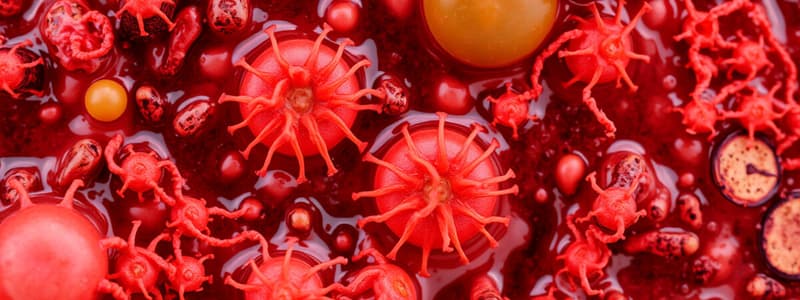Podcast
Questions and Answers
What describes a reservoir in terms of pathogens?
What describes a reservoir in terms of pathogens?
- A place where pathogens can survive but not multiply (correct)
- A place where pathogens always multiply
- A place where pathogens cause immediate illness
- A location that only houses beneficial microorganisms
Which microorganism can grow in nebulizer reservoirs?
Which microorganism can grow in nebulizer reservoirs?
- E. coli
- Pseudomonas organisms (correct)
- Legionella pneumophila
- Hepatitis A virus
What is the most common reservoir for pathogens?
What is the most common reservoir for pathogens?
- Water
- The human body (correct)
- Inanimate objects
- Animal bodies
What term describes individuals who carry pathogens without showing symptoms?
What term describes individuals who carry pathogens without showing symptoms?
Which of the following can be a reservoir for infectious organisms?
Which of the following can be a reservoir for infectious organisms?
In which form do pathogens colonize the human body?
In which form do pathogens colonize the human body?
Which virus can be carried without any signs or symptoms of infection?
Which virus can be carried without any signs or symptoms of infection?
Legionella pneumophila is associated with which setting?
Legionella pneumophila is associated with which setting?
Which scenario best defines colonization?
Which scenario best defines colonization?
What is one effect of a pathogen being a carrier?
What is one effect of a pathogen being a carrier?
What type of bacteria primarily require oxygen to survive and multiply?
What type of bacteria primarily require oxygen to survive and multiply?
Which temperature range is considered optimal for most human pathogens?
Which temperature range is considered optimal for most human pathogens?
What characteristic of spores allows certain bacteria to survive without water?
What characteristic of spores allows certain bacteria to survive without water?
What pH range do most microorganisms prefer for viability?
What pH range do most microorganisms prefer for viability?
What type of bacteria primarily causes infections in deep tissues where oxygen is limited?
What type of bacteria primarily causes infections in deep tissues where oxygen is limited?
What environmental condition generally prevents the growth of bacteria?
What environmental condition generally prevents the growth of bacteria?
Which type of bacteria can thrive in the alkaline conditions found in urine?
Which type of bacteria can thrive in the alkaline conditions found in urine?
Which of the following organisms is known to survive in oxygen-free environments?
Which of the following organisms is known to survive in oxygen-free environments?
Which of the following is a potential effect of acid-reducing medications on gastrointestinal microorganisms?
Which of the following is a potential effect of acid-reducing medications on gastrointestinal microorganisms?
What type of light can be effective in killing certain forms of bacteria?
What type of light can be effective in killing certain forms of bacteria?
Flashcards are hidden until you start studying
Study Notes
Reservoirs and Pathogens
- A reservoir is a habitat in which a pathogen can survive, but it may not necessarily multiply.
- Common examples include the human body, animals, food, water, insects, and inanimate objects.
- Hepatitis A virus survives in shellfish without multiplying; Pseudomonas species can survive and multiply in nebulizers.
- Colonization occurs when pathogens are present in the body without causing harm.
- Carriers harbor pathogens without symptoms, such as individuals infected with hepatitis B virus.
Environmental Requirements for Pathogens
- Pathogens require specific conditions to thrive, including food, oxygen, water, temperature, pH, and low light.
Food
- Microorganisms need nourishment; some thrive on organic materials (e.g., Clostridium perfringens causes gas gangrene).
- Others, like Escherichia coli, consume undigested food in the intestines.
- Organisms can also obtain nutrients from carbon dioxide and inorganic materials like soil.
Oxygen
- Aerobic bacteria need oxygen to grow and multiply, causing more infections than anaerobic counterparts.
- Examples of aerobic organisms include Staphylococcus aureus and certain Streptococcus strains.
- Anaerobic bacteria, residing in the gastrointestinal tract, can lead to infections when the bowel is compromised.
Water
- Most pathogens require moisture to survive; they often thrive in wet environments.
- Bacteria may form spores that allow them to endure dryness, such as those causing anthrax, botulism, and tetanus.
Temperature
- Pathogens generally thrive at human body temperatures (35°C to 37°C), while some can withstand extreme temperatures.
- Cold temperatures tend to inhibit bacterial growth and reproduction.
pH
- The acidity of the environment affects pathogen viability; most prefer a pH range of 5 to 8.
- Certain bacteria flourish in alkaline urine but many cannot survive the acidic environment of the stomach.
- Acid-reducing medications may lead to an overgrowth of gastrointestinal organisms, risking healthcare-associated pneumonia.
Minimal Light
- Microorganisms generally prefer dark environments, which can be found under dressings and within body cavities.
- Ultraviolet light is effective in destroying specific bacterial forms, such as Mycobacterium tuberculosis.
Studying That Suits You
Use AI to generate personalized quizzes and flashcards to suit your learning preferences.




